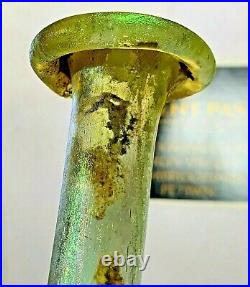
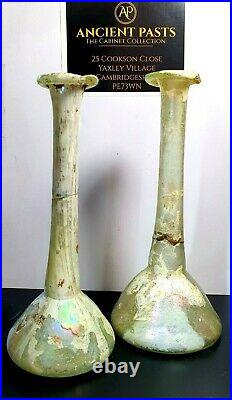
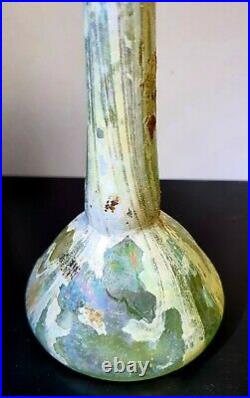
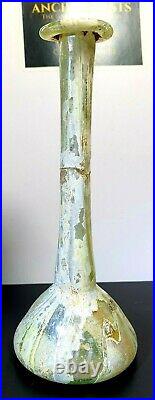
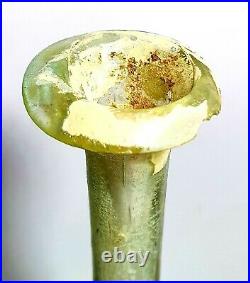
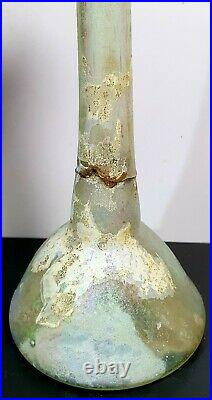
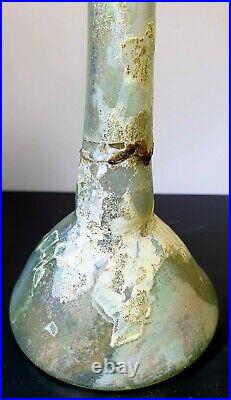
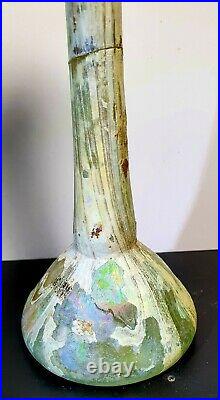
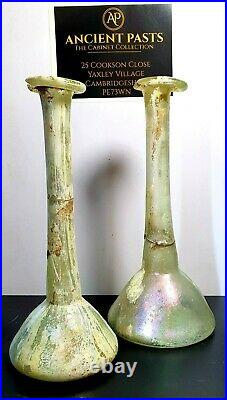
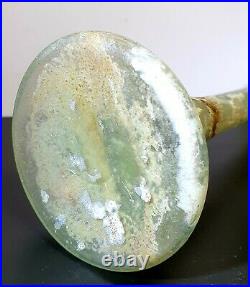
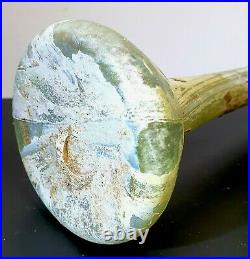
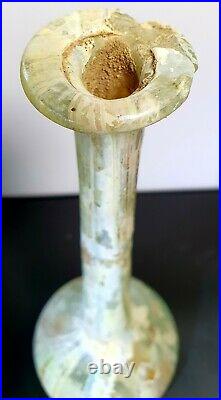

Add To Saved Sellers. Very Rare Large Ancient Roman Glass / Vitrum Candlestick Unguentaria Roman Glass. N unguentarium (plural “Unguentaria”) is a small ceramic or glass bottle found frequently by archaeologists at Hellenistic and Roman sites, especially in cemeteries. Its most common use was probably as a container for oil, though it is also suited for storing and dispensing liquid and powdered substances. Some finds date into the early Christian era. From the 2nd to the 6th century, they are more often made of blown glass rather than clay. A few examples are silver or alabaster. Unguentaria were used as product packaging in commerce and for funerary practice. They are distributed throughout the Mediterranean region of the Roman Empire from Israel to Spain, and north into Britain and Germania. Their manufacture was nearly as widespread. Unguentaria were extremely popular throughout the Roman Empire, used to store and preserve oils and perfumes. The small containers were perfect for storing such expensive liquids, which were considered precious. Small Unguentaria were used in different ceremonies (in public and private life) and were often left at graves as funeral offerings. A set of two large Candlestick Unguentarium, with iridescence seen to all surfaces with excellent’sand drying pit marks’ and very well developed calcite formations: the lips of the vases are well turned with fine irregularities in thickness and’drying melt marks’ are seen at these location: it is impossible to’fake’ this type and degree of original ware and I mention this not in concern to this pieces, but for anyone viewing’so called’ roman glass. Any patina that washes away is a chemical application and fake. We have even seen middle eastern forgers use old Roman glass fragments and melt them down to re-blow vessels however, you cannot fake a genuine original patina as here – just wonderfully rare and in the degree of preservation even rarer. The pieces are complete, and both have only one break and restoration to the necks of the unguentaria: These has been carefully adhered in the distant past. I have reinforced the adhesion to allow me confidence in the current tensile strength. The remarkable fact about these objects is that they are likely to be about 1,900 years old and has survived as seen here with just a single break, which I strongly suspect was inflicted in the buried context and or when the object was lifted back into the light of day. Overall height: 160 mm: base diametre: 75 mm: weight: 89.25 grams. Overall height: 155 mm: base diametre: 63 mm: weight: 91.33 grams. Very Fine to Extremely Fine. Both examples are complete with old restoration to the necks where ancient breaks have occurred: Stunning airborne and substrata patination with beautiful iridescence seen to all surfaces: Fine calcite encrustations seen to several locations: I have captured in my macro-photography where only light and contrast are adjusted in the editing process after the studio image capture. Roman glassware from British finds in Allen, D. Roman Glass in Britain, Princes Risborough, 1998. The Candlestick Unguentaria were acquired from a private German collection, where Celtic and Roman material feature in very fine condition. It is said however, cannot now be proved due to age, that the piece was originally discovered in the former Roman province of’Raetia’ in central Europe in the early 1900’s by an antiquarian excavating a Roman Civitas / suspected town location. Indeed, I suspect that it must have been removed from a cemetery context as this is where such items were left filled with perfumes / oils and libations for the deceased. It has nonetheless survived in excellent condition and gives us a rare opportunity to appreciate the art of the object itself. The use of the man-made material called glass – a mix of soda, silica, and lime – pre-dates the Romans by over 1,500 years, but even they seem not to have fully understood the complexity of the component mix and the necessity for lime to make the glass impervious to water and much more durable to the ravages of time and use. Lime can be found naturally, for example, as part of the silica component in the form of sand which contains a significant percentage of crushed seashells. Indeed, two areas became noted for the high quality of their glass – along the Belarus River in Phoenicia and the Volturnus River in Campania – not coincidentally, areas where the sand was particularly rich in lime. However, some Roman glassmakers, perhaps without knowing exactly why, did understand that the addition of small pebbles and shells could affect the final quality of the glass produced. The use of glass before Roman times was mainly restricted to small opaque bottles or large bowls, very often made in imitation of metal-wares. Early glass was usually opaque due to the high number of tiny air bubbles within the glass because of the firing process and usually had a pale green or yellow hue due to the presence of impurities. The colour tint of the glass could, though, be manipulated by increasing or decreasing the level of oxygen in the furnace. Colours could also be achieved by adding small amounts of metals to the mix; adding copper produced blue, green, and red, manganese produced pink and red, cobalt a deep blue, calcium white, and lead brought a yellow tint. With the invention of glassblowing (blowing the glass whilst still hot through a hollow iron rod 1 to 1.5 m long) in the 1st century BCE, a better quality of glass was produced, and the production process became faster and cheaper with the consequence that vessels made from glass became much more common, everyday objects. This trend was increased further by the invention of the glassblowing furnace in the 1st century CE. As Strabo noted in his Geography, a glass vessel could be bought in the 1st century CE for only a copper coin. The exact location and time of the invention of this new production method is not known, but the earliest examples of blown glass date from the 1st century BCE in the areas of Syria and Palestine. This is also the time when the Latin word for glass – vitrum – is first recorded. This item is in the category “Collectables\Decorative Collectables\Other Decorative Collectables”. The seller is “ancientpasts” and is located in this country: GB. This item can be shipped worldwide.
- Brand: Roman
- Type: Glass
- Era: 2nd Century AD
- Ancient Roman Unguentaria: Ancient Roman Glass
- Bundle Description: Unguentaria Roman Glass
- Style: Roman
- Material: Glass
- MPN: Unguentaria
- Unit Quantity: 2
- Colour: Green to Clear

